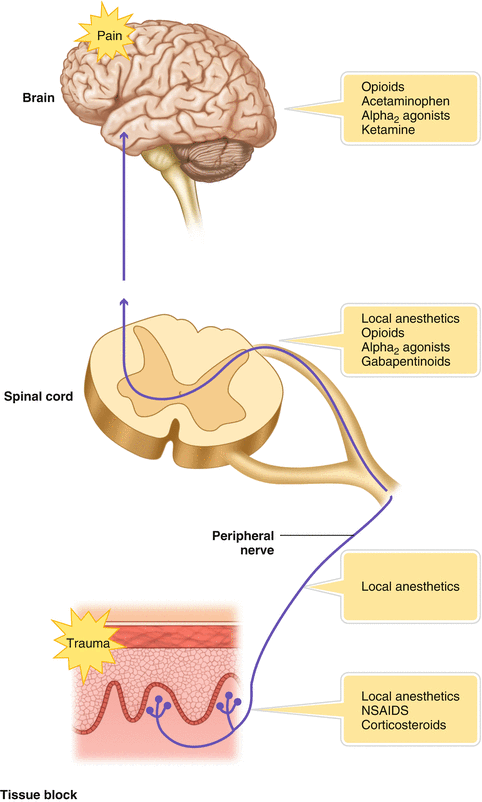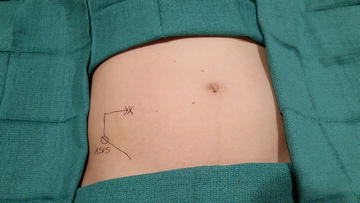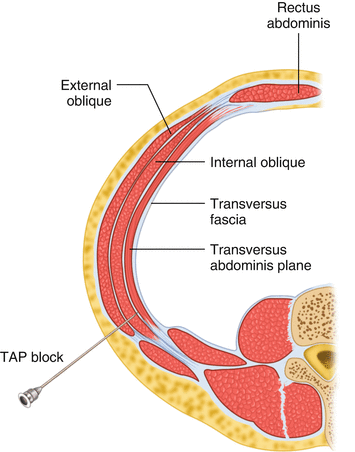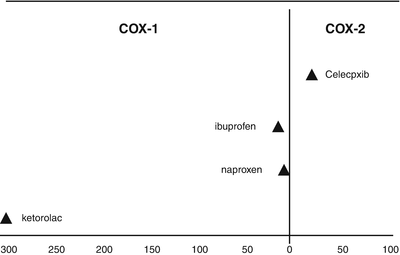Fig. 14.1.
Nociceptive pain pathway.

Fig. 14.2.
Comprehensive view of pain pathway with multimodal points of modulation.
Multimodal Analgesics for Acute Pain Management
There are multiple analgesics that can be used to modulate the pain pathway. Beginning in the periphery and working toward the central nervous system, these include (Table 14.1):
Table 14.1.
Summary of analgesics for multimodal pain therapy.
Agent | Mode of Action | Dose | Safety |
|---|---|---|---|
Local anesthetics | Nerve conduction blockade | Ropivacaine 0.2 % infiltration Bupivacaine 0.1–0.25 % infiltration Bupivacaine liposome injectable suspension (EXPAREL) 1.3 % infiltration | Neurotoxicity and cardiotoxicity |
NSAIDs | COX-2 inhibition | IV: ketorolac 15–30 mg q6 h PO: celecoxib 200 mg BID | Wound site and GI bleedinga, renal toxicityb |
Gabapentinoids | α2δ ion channel blockade | Gabapentin 600 mg po TID Pregabalin 100 mg po BID | Sedationc |
α-agonists (Clonidine) | Enhanced monoamine-mediated analgesia | Patch: 0.1 mg/24 h | Hypotension and bradycardia |
Acetaminophen (APAP) | GABA inhibition, serotonergic interaction | PO: 650 mg q6 h IV: 1000 mg q6 h | Hepatotoxicity |
Opioids | μ-receptor agonist | Varied depending on formulation | Sedation, hypotension, respiratory depression, nausea |
Ketamine | Nonselective NMDA antagonism | 1 mg/kg/h infusion | Hallucinations, confusion |
Local Anesthetics
Local anesthetics are aminoamide or aminoester compounds that temporarily block the sodium channels in the nociceptive nerves, preventing conduction of the pain signal. They may be infiltrated into tissue to block nerves locally, regionally to block pain perception from an area of the body, or around the spinal cord to block transmission of pain signals to the brain. They may also be short acting (lidocaine: 1–2 h duration), intermediate acting (bupivacaine: 3–6 h duration), or long acting (liposomal bupivacaine: 72 h duration). Local anesthetics may also be continuously pumped into the surgical site using an elastomeric or electrical pump in an effort to prolong the duration of their effect. For hernia surgery, local anesthetics may be applied using four different techniques: inguinal nerve block (discrete nerve block at the site of the ilioinguinal, iliohypogastric, and/or genitofemoral nerve); field block (infiltration into the superficial and deeper structures in the field of surgery, which may result in a block of the ilioinguinal, iliohypogastric, and/or genitofemoral nerve); infiltration (injection of local anesthetic into the cutaneous/subcutaneous/deeper structures of the surgical field); and instillation (local anesthetic application without needles (e.g., spray) into the surgical site).
Techniques for Administration of Local Anesthetics
Inguinal Nerve Block
The ilioinguinal and iliohypogastric nerves can be blocked by a directed administration of local anesthetic pre- or intraoperatively. Beginning two fingerbreadths superior and medial to the anterior superior iliac spine, a 1.5 inch needle is introduced deep into the abdominal wall, targeting the layers between the internal and external oblique fascia (Fig. 14.3). Depth is estimated by feeling for the “pop” of the needle across the external oblique fascial layer and 10 mL of long-acting local anesthetic (bupivacaine or liposomal bupivacaine) is infiltrated.


Fig. 14.3.
Landmarks for inguinal nerve block.
Transversus Abdominis Plane Block
This procedure is done under ultrasound or laparoscopic guidance and used to block T11–L1 cutaneous, myofascial, and peritoneal nerves, including the iliohypogastric and ilioinguinal nerves. It provides excellent pain relief for surgeries involving the infra-umbilical abdominal wall. Under ultrasound guidance, a blunt-tipped 22-gauge needle is inserted into the abdominal wall two fingerbreadths above the iliac crest along the mid-axillary line and advanced into the plane between the transversus abdominis and internal oblique muscles (Fig. 14.4). After aspirating to exclude a vascular puncture, 5 mL of local anesthetic is infiltrated while ultrasound imaging confirms separation of the two muscles and infiltration into the correct plane. Once confirmed, an additional 15 mL of anesthetic is infiltrated. The genital branch of the genital–femoral nerve runs on the posterior aspect of the spermatic cord and is most commonly identified where the cord crosses the pubic tubercle. Some surgeons infiltrate local anesthetic into the spermatic cord at this area in an attempt to block this nerve.


Fig. 14.4.
Transversus abdominis plane (TAP) block.
During laparoscopic surgery, the transversus abdominis plane (TAP) block can be done without ultrasound, using intra-abdominal visualization. The needle is passed using the same external landmarks and advanced under laparoscopic monitoring into the plane just above the transversus abdominis muscle. A test injection should demonstrate an obvious bulge without elevation of the peritoneum.
Field Block
Local anesthetic is infiltrated into the surgical field. This begins with infiltration of the dermal layer of the skin beyond the planned area of incision. Each layer encountered is then infiltrated with additional anesthetic. The subcutaneous layer is infiltrated using a fanning technique extending both superiorly and inferiorly from the wound. The external oblique aponeurosis, internal oblique fascia, and transversus abdominis fascia are also injected.
Instillation
Local anesthetic may be applied to the surgical area by simple instillation, without the use of a needle. The surgeon essentially bathes the field in local anesthetic. This is done at the time of closure in open inguinal surgery and prior to port removal for TEP or just after peritoneal closure in TAPP (needle puncture of peritoneum required).
Nonsteroidal Anti-Inflammatory Drugs
Nonsteroidal Anti-Inflammatory Drugs (NSAIDS) play a key role in multimodal analgesia as adjuncts or alternatives to opioids. They modulate the inflammatory pain pathway by blocking cyclo-oxygenase (COX) enzymes . When cells die or are damaged, arachidonic acid is released from the cell walls and acted upon by one of two COX enzymes. The COX-1 enzyme is normally expressed in the body and is considered a “homeostatic” isoform that converts arachidonic acid to prostaglandins that are used to promote platelet aggregation, renal blood flow, and gastric mucosal protection. The COX-2 enzyme is minimally expressed normally, but greatly upregulated following trauma or surgery. It promotes conversion of arachidonic acid to prostaglandin E2 (PGE2), which activates nociceptors and initiates the inflammatory cascade. NSAIDs are classified based on their effect on COX-1 versus COX-2. For pain control, it is ideal to have selective COX-2 inhibition without interfering with COX-1, which can increase the risk of bleeding, gastric ulceration, or renal damage. Figure 14.5 details the COX-2 versus COX-1 inhibition of common NSAIDS used in the USA.


Fig. 14.5.
Inhibition of COX-2 relative to COX-1.
Corticosteroids
Corticosteroids are potent anti-inflammatory drugs that can reduce the intensity of postsurgical pain. They stabilize lysosomal membranes in injured cells, decreasing the release of arachidonic acid, which in turn reduces the production of prostaglandins and leukotrienes. The clinical analgesic effect of corticosteroids is delayed in comparison to NSAIDs, taking up to 4 h. However, the duration of analgesia provided by a single dose can last up to 3 days [3]. In low doses, corticosteroids are also potent antiemetics.
Gabapentinoids
Gabapentin and pregabalin are anticonvulsant analgesics approved by the FDA for the treatment of neuropathic pain such as fibromyalgia or post-herpetic neuralgia. However, they are increasingly being used for acute surgical pain management. Both drugs have a high affinity for presynaptic calcium channels, which decreases the influx of calcium and decreases the release of excitatory neurotransmitters in the spinal and supraspinal pain pathways. They also decrease the excitability of peripheral nociceptive nerves.

Full access? Get Clinical Tree





